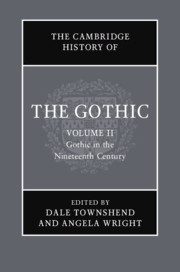Book contents
- The Cambridge History of the Gothic
- The Cambridge History of the Gothic
- The Cambridge History of the Gothic
- Copyright page
- Contents
- Illustrations and Captions for Volume II
- Tables
- Notes on Contributors
- Acknowledgements
- Introduction: Gothic in the Nineteenth Century, 1800–1900
- 2.1 Gothic Romanticism and the Summer of 1816
- 2.2 Fantasmagoriana: The Cosmopolitan Gothic and Frankenstein
- 2.3 The Mutation of the Vampire in Nineteenth-Century Gothic
- 2.4 From Romantic Gothic to Victorian Medievalism: 1817 and 1877
- 2.5 Nineteenth-Century Gothic Architectural Aesthetics: A. W. N. Pugin, John Ruskin and William Morris
- 2.6 Gothic Fiction, from Shilling Shockers to Penny Bloods
- 2.7 The Theatrical Gothic in the Nineteenth Century
- 2.8 ‘Spectrology’: Gothic Showmanship in Nineteenth-Century Popular Shows and Media
- 2.9 The Gothic in Victorian Poetry
- 2.10 The Genesis of the Victorian Ghost Story
- 2.11 Charles Dickens and the Gothic
- 2.12 Victorian Domestic Gothic Fiction
- 2.13 The Gothic in Nineteenth-Century Spain
- 2.14 The Gothic in Nineteenth-Century Italy
- 2.15 The Gothic in Nineteenth-Century Scotland
- 2.16 The Gothic in Nineteenth-Century Ireland
- 2.17 The Gothic in Nineteenth-Century America
- 2.18 Nineteenth-Century British and American Gothic and the History of Slavery
- 2.19 Genealogies of Monstrosity: Darwin, the Biology of Crime and Nineteenth-Century British Gothic Literature
- 2.20 Gothic and the Coming of the Railways
- 2.21 Gothic Imperialism at the Fin de siècle
- Select Bibliography
- Index
2.18 - Nineteenth-Century British and American Gothic and the History of Slavery
Published online by Cambridge University Press: 18 July 2020
- The Cambridge History of the Gothic
- The Cambridge History of the Gothic
- The Cambridge History of the Gothic
- Copyright page
- Contents
- Illustrations and Captions for Volume II
- Tables
- Notes on Contributors
- Acknowledgements
- Introduction: Gothic in the Nineteenth Century, 1800–1900
- 2.1 Gothic Romanticism and the Summer of 1816
- 2.2 Fantasmagoriana: The Cosmopolitan Gothic and Frankenstein
- 2.3 The Mutation of the Vampire in Nineteenth-Century Gothic
- 2.4 From Romantic Gothic to Victorian Medievalism: 1817 and 1877
- 2.5 Nineteenth-Century Gothic Architectural Aesthetics: A. W. N. Pugin, John Ruskin and William Morris
- 2.6 Gothic Fiction, from Shilling Shockers to Penny Bloods
- 2.7 The Theatrical Gothic in the Nineteenth Century
- 2.8 ‘Spectrology’: Gothic Showmanship in Nineteenth-Century Popular Shows and Media
- 2.9 The Gothic in Victorian Poetry
- 2.10 The Genesis of the Victorian Ghost Story
- 2.11 Charles Dickens and the Gothic
- 2.12 Victorian Domestic Gothic Fiction
- 2.13 The Gothic in Nineteenth-Century Spain
- 2.14 The Gothic in Nineteenth-Century Italy
- 2.15 The Gothic in Nineteenth-Century Scotland
- 2.16 The Gothic in Nineteenth-Century Ireland
- 2.17 The Gothic in Nineteenth-Century America
- 2.18 Nineteenth-Century British and American Gothic and the History of Slavery
- 2.19 Genealogies of Monstrosity: Darwin, the Biology of Crime and Nineteenth-Century British Gothic Literature
- 2.20 Gothic and the Coming of the Railways
- 2.21 Gothic Imperialism at the Fin de siècle
- Select Bibliography
- Index
Summary
This chapter explores how slave insurrections in the Caribbean and West Indies throughout the late eighteenth and nineteenth centuries impacted upon British and American Gothic writing. In particular, it argues that the Gothic mode became, and remains still, haunted by an ever-present racialised discourse, one which reveals the horror of modernity’s constructions and their inheritances. From the nineteenth century onwards, Gothic texts not only ask what it means to be a (wo)man among the human race, but anxiously investigate the lie of racial difference. Examining texts by Charlotte Dacre, Mary Shelley, Emily Brontë, Herman Melville and Florence Marryat, the chapter explores how the Gothic depicts acts of black rebellion in unequivocal tones of horror, and the extent to which their black (enslaved) characters assume the place of the utterly monstrous while also betraying anxiety over the blurry line separating blacks from whites. Such fictions, the argument holds, debate the justice of violent black revolution and express the concern that, while slavery itself may be responsible for the violence of the enslaved, slavery may in fact debase white subjects too.
Keywords
- Type
- Chapter
- Information
- The Cambridge History of the Gothic , pp. 394 - 415Publisher: Cambridge University PressPrint publication year: 2020

